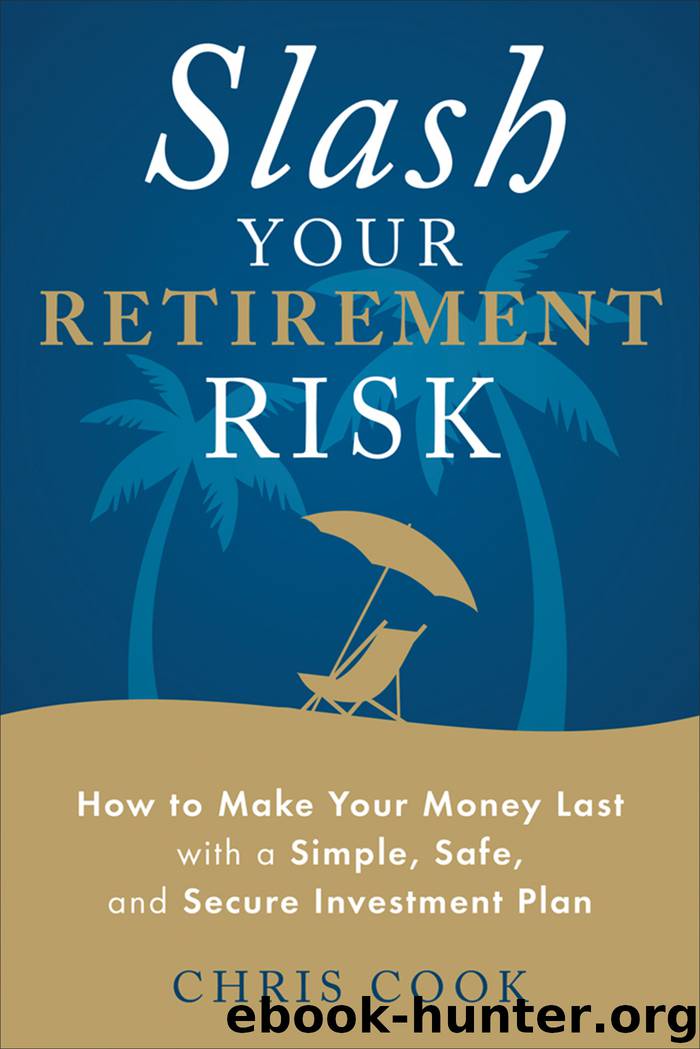Slash Your Retirement Risk by Chris Cook

Author:Chris Cook
Language: eng
Format: epub
Publisher: Career Press
Published: 2017-02-22T16:00:00+00:00
To illustrate the power of being right only half the time, let’s compare long-term portfolio returns. With the New ROI approach, a portfolio experienced a 10.40-percent annualized return for the last 20 years (ending July 31, 2016) compared with an 8.21-percent return for the S&P 500. That’s a 2.21-percent difference. That may not sound significant, but over 20 years that adds up to an increase of $274,000 on a $500,000 portfolio.
10 Percent and Why
The New ROI approach targets a 10-percent drop in the S&P 500 Index as the optimal point to stop the loss—to sell off a portfolio’s equity holdings and temporarily park the resulting cash in a safe haven. (I’ll talk about the best safe havens a bit later in this chapter.)
That number isn’t arbitrary; it’s backed by scientific analysis. Remember that I talked about the momentum of losses in the last chapter and what can and does happen once the market slips by 10 percent.
With the New ROI do-it-yourself version, tracking market movements doesn’t have to be about constant exasperation with and worry about the daily ups and downs of markets. Instead, on the last day of each month, you can go online to check the S&P 500 Index. The information is available on plenty of websites, including Yahoo/Finance and Google/Finance, or you can use a preferred search engine or website.
If the index is down 10 percent from its high point since you purchased the equities in your portfolio, that’s the signal it’s time get out—to stop the loss and sell all your stock holdings across the various sectors. Take the resulting cash from the sell-off and move it temporarily into a safe haven. If the S&P is off only 9 percent, leave your equity holdings alone, and check back again in a month. If it’s off any more than 10 percent, get out. Sell off the equities.
If markets seem especially volatile during any month, or if it simply makes you feel better to check the S&P 500 number more often, that’s okay, too. Sometimes investors who subscribe to the DIY New ROI prefer to check the numbers more frequently, at least in the beginning until they get comfortable with the reliability of the system.
We base that 10-percent falling-markets marker on our scientifically sound back-testing, which includes 20-year scenarios that provide an accurate and honest picture of how the strategy works across all kinds of situations. However, you are only looking at the S&P once per month, so it may be down more than our 10-percent target threshold. That’s not the end of the world. The important take away is that you limited your losses from becoming truly destructive and provide your money an opportunity for quicker recovery.
Fig. 7.2 Stop-Loss Illustrated
Download
This site does not store any files on its server. We only index and link to content provided by other sites. Please contact the content providers to delete copyright contents if any and email us, we'll remove relevant links or contents immediately.
| Budgeting & Money Management | College & Education Costs |
| Credit Ratings & Repair | Retirement Planning |
The Compound Effect by Darren Hardy(7623)
Tools of Titans by Timothy Ferriss(7004)
Nudge - Improving Decisions about Health, Wealth, and Happiness by Thaler Sunstein(6669)
Win Bigly by Scott Adams(6345)
Pioneering Portfolio Management by David F. Swensen(5633)
Deep Work by Cal Newport(5552)
Principles: Life and Work by Ray Dalio(5361)
The Barefoot Investor by Scott Pape(5331)
Rich Dad Poor Dad by Robert T. Kiyosaki(5191)
Grit by Angela Duckworth(4761)
The Slight Edge by Jeff Olson(4746)
Discipline Equals Freedom by Jocko Willink(4659)
Digital Minimalism by Cal Newport;(4620)
The Motivation Myth by Jeff Haden(4556)
You Are a Badass at Making Money by Jen Sincero(4274)
The Four Tendencies by Gretchen Rubin(4044)
The Confidence Code by Katty Kay(3599)
Eat That Frog! by Brian Tracy(3551)
Captivate by Vanessa Van Edwards(3320)
